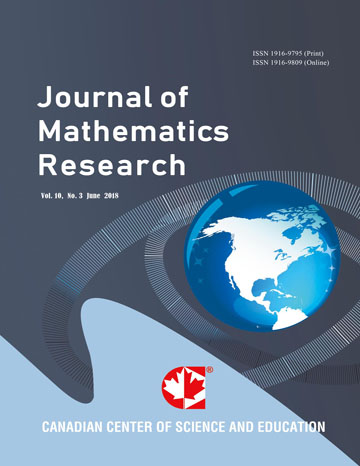Edge-Maximal Graphs Containing No $r$ Vertex-Disjoint Triangles
- Mohammad Hailat
Abstract
An important problem in graph theory is that of determining the maximum number of edges in a given graph $G$ that contains no specific subgraphs. This problem has attracted the attention of many researchers. An example of such a problem is the determination of an upper bound on the number of edges of a graph that has no triangles. In this paper, we let $\mathcal{G}(n,V_{r,3})$ denote the class of graphs on $n$ vertices containing no $r$-vertex-disjoint cycles of length $3$. We show that for large $n$, $\mathcal{E}(G)\les \lfloor \frac{(n-r+1)^2}{4} \rfloor +(r-1)(n-r+1)$ for every $G\in\mathcal{G}(n,V_{r,3})$. Furthermore, equality holds if and only if $G=\Omega(n,r)=K_{r-1,\lfloor \frac{n-r+1}2\rfloor,\lceil \frac{n-r+1}2\rceil}$ where $\Omega(n,r)$ is a tripartite graph on $n$ vertices.- Full Text:
 PDF
PDF
- DOI:10.5539/jmr.v10n1p110
Journal Metrics
- h-index (December 2021): 22
- i10-index (December 2021): 78
- h5-index (December 2021): N/A
- h5-median (December 2021): N/A
( The data was calculated based on Google Scholar Citations. Click Here to Learn More. )
Index
- Academic Journals Database
- ACNP
- Aerospace Database
- BASE (Bielefeld Academic Search Engine)
- Civil Engineering Abstracts
- CNKI Scholar
- COPAC
- DTU Library
- EconPapers
- Elektronische Zeitschriftenbibliothek (EZB)
- EuroPub Database
- Google Scholar
- Harvard Library
- IDEAS
- Infotrieve
- JournalTOCs
- LOCKSS
- MathGuide
- MathSciNet
- MIAR
- PKP Open Archives Harvester
- Publons
- RePEc
- ResearchGate
- Scilit
- SHERPA/RoMEO
- SocioRePEc
- Standard Periodical Directory
- Technische Informationsbibliothek (TIB)
- The Keepers Registry
- UCR Library
- Universe Digital Library
- WorldCat
Contact
- Sophia WangEditorial Assistant
- jmr@ccsenet.org
